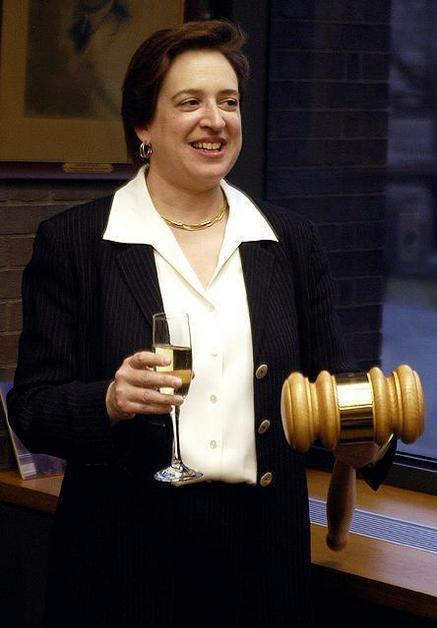
Kagan, seen during a champagne reception celebrating her appointment as Dean of Harvard Law School in this April 2003 file photo, ascended to the position only two years after receiving tenure. In 2009, she left the Law School to serve as solicitor general and was nominated to the Supreme Court in 2010.
It happens—or will happen—to all of us. And during her first year on the U.S. Supreme Court, it happened to Associate Justice Elena Kagan.
She got jury duty.
Like any Washington D.C. resident, she reported to the Moultrie Courthouse—a stocky, busy, fluorescent-lit federal building where the constant traffic has left a layer of grime on its facade. Kagan went to the third floor, stood in line at the jurors’ office, and proceeded to wait in the the jury room—a vast space with paintings of African tribal women on the walls and with windows that look down on a Cosi and an Au Bon Pan. Amicably chatting with the few people who recognized her, Kagan pulled out documents and began working away, making notes in the margin of a legal brief.
The image of Kagan, dutifully showing up for court with the rest of the city’s residents, is in one way representative of her brief tenure on the court. During that time, Kagan has made a point of making her opinions more accessible to the public, writing in a colloquial, approachable style that bears surprising resemblance to a fellow justice, Antonin G. Scalia.
Scalia has come to be indisputably recognized as the court’s best writer and as someone who forcefully and unabashedly expresses the hopes and ideals of conservative jurisprudence. And in two dissents this year it appears Kagan may be emerging as a similar figure for the left.
One year ago Saturday, Kagan was sworn in as an associate justice of the U.S. Supreme Court. The early verdict on her first year indicates that Kagan is not only shaping up as the liberal bloc’s most eloquent voice but also as a consensus builder in the style of Chief Justice John G. Roberts ’67 who has proven to be highly influential in building majority coalitions.
Kagan’s first year—during which she recused herself from nearly as many cases as she judged—offers only a premature indication of her future on the court but does give a glimpse of a feisty jurist who seems to be quickly finding her voice as a justice.
LEADER OF THE LEFT?
Kagan has never been afraid of speaking up.
As a girl living on the Upper West Side of Manhattan, Kagan negotiated with her Rabbi for a more serious bat mitzvah ceremony, one more like the male bar mitzvah. At the time, it was not customary at her synagogue for women to read the Torah or have their services on the Jewish sabbath.
The story of Kagan’s coming of age ceremony is often cited as an example of Kagan’s forceful, somewhat iconoclastic personality, a sense of determination and diplomacy that experts think could make Kagan a leader among the Supreme Court’s liberal judges.
Law School Lecturer Thomas C. Goldstein—who has argued many cases before the court and founded the influential SCOTUSblog—says that Kagan’s ability to communicate with and ultimately convince colleagues will ultimately make her a player.
“She just has what everyone acknowledges as an unbelievable capacity to deal with people, [and to] get other people to listen to her,” Goldstein says.
Goldstein says that so far, Kagan has “focused her fire,” only asking questions or making arguments when they were particularly poignant. While Kagan has worked in the past to prevent being perceived as an ideologue—what Goldstein calls “not putting herself in a box”—that hasn’t stopped watchers of the court from trying.
Many liberals hope that Kagan—an outspoken lawyer who has never been afraid to shake up even the most storied of institutions—would emerge as a ‘Scalia of the Left,’ someone who would be able to articulate the ideals of the left in decisive and understandable prose.
Read more in News
Harvard Lampoon Loses Domain ComplaintRecommended Articles
-
A Promising AppointmentFifty years ago, Harvard Law School (HLS) first opened its doors to a handful of female law students. Last week,
-
Kagan Stresses GrowthHarvard Law School Dean Elena Kagan highlighted her accomplishments in growing the school’s faculty, expanding its campus, and revising its
-
Another Feather in Kagan's CapThe Harvard Law faculty’s unanimous endorsement of extensive first-year curriculum reforms last week could strengthen Law School Dean Elena Kagan’s
-
Under Kagan, A Harmonious HLSThis is the sixth article in a continuing series. Part 1: Prov
-
Kagan Discusses Statutory Interpretation at Law SchoolSupreme Court Associate Justice Elena Kagan discussed what she described as “remarkable” changes in interpretation of statutory law in a conversation with law professor John F. Manning ’82 during an event at the Law School on Tuesday.













